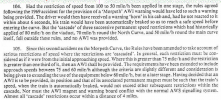Inversnecky
Member
We know about Morpeth boards and permanent AWS alerts before significant speed limit decreases (30% of final), but were there other occasions where AWS magnets were located ahead of general lower speed signs (eg the usual 5/10/15 mph)?
On another forum, a contributor who states he was a former driver was insisting that he encountered AWS alerts before any/all speed decreases.
Was this true, at least somewhere on the network regions, at sometime in the past, or is this simply a case of misremembering after many years?
I can’t see why you’d need alerts for every change of speed: the important alerts would be diminished by the fog of the mundane.
On another forum, a contributor who states he was a former driver was insisting that he encountered AWS alerts before any/all speed decreases.
Was this true, at least somewhere on the network regions, at sometime in the past, or is this simply a case of misremembering after many years?
I can’t see why you’d need alerts for every change of speed: the important alerts would be diminished by the fog of the mundane.










